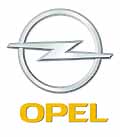

Up to 266
Newton meters with overboost
Zero to
100 km/h in 7.2 seconds
Top speed
225 km/h · Pure Corsa driving fun

Mit Overboost bis 266
Newtonmeter
In 7,2 Sekunden auf Tempo 100
Höchstgeschwindigkeit 225
km/h
Corsa-Fahrspaß in
Reinkultur |
Opel Corsa OPC: Most Powerful Corsa Ever
Rüsselsheim.
Opel is shifting into top gear with the new Corsa OPC. Following the sensational
market launch of the Opel bestseller's fourth generation, the OPC version
is now the quintessential expression of the Corsa's dynamic
character.
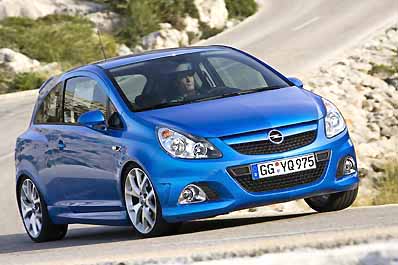 Top-level agility and vehicle control ensure pure Corsa driving
fun. Its 1.6-liter turbo engine with 141 kW/192 hp accelerates the compact
three-door from zero to 100 km/h in 7.2 seconds and enables a top speed of
225 km/h. The maximum torque of 230 Nm is delivered to the front wheels by
the standard six-speed transmission. In addition, the standard 'overboost'
system can temporarily increase torque by around 15 percent to 266 Nm when
required, providing a corresponding dynamics increase. This level of performance
provides the newest member of the sporty OPC family, which now includes six
models, with superb propulsion power in all driving situations. For instance,
accelerating from 80 to 120 km/h takes just 6.7 seconds in fifth gear. The
Corsa OPC requires 7.9 liters of fuel per 100 kilometers, a moderate figure
in this performance class. The first models are already available at Opel
dealerships this month. Top-level agility and vehicle control ensure pure Corsa driving
fun. Its 1.6-liter turbo engine with 141 kW/192 hp accelerates the compact
three-door from zero to 100 km/h in 7.2 seconds and enables a top speed of
225 km/h. The maximum torque of 230 Nm is delivered to the front wheels by
the standard six-speed transmission. In addition, the standard 'overboost'
system can temporarily increase torque by around 15 percent to 266 Nm when
required, providing a corresponding dynamics increase. This level of performance
provides the newest member of the sporty OPC family, which now includes six
models, with superb propulsion power in all driving situations. For instance,
accelerating from 80 to 120 km/h takes just 6.7 seconds in fifth gear. The
Corsa OPC requires 7.9 liters of fuel per 100 kilometers, a moderate figure
in this performance class. The first models are already available at Opel
dealerships this month. |
Design: Reminiscence
of motor sport vehicles
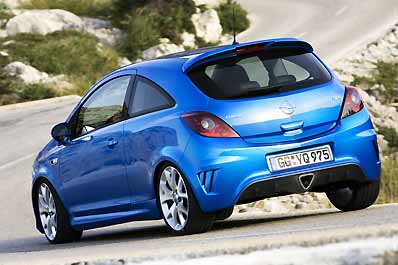 The sporty lines of the three-door Corsa are even more striking
in the OPC variant. The roof spoiler, as well as the powerful front and rear
aprons with distinctive gills make the OPC a real eye-catcher. Elements such
as the darkly contrasting diffuser with integrated, centrally located triangular
tailpipe and specially designed exterior mirrors are just a few examples
of how much attention to detail was put into further developing the Corsa's
bold, sporty character. Sportiness also dominates the Corsa OPC's cockpit.
In addition to the typical OPC door sills, chrome-ringed instruments with
red pointers and - depending on upholstery color - blue or silver-ringed
air vents, the flat-bottomed leather sports steering wheel is especially
eye-catching. Also reminiscent of motor sport vehicles, the steering wheel
features a ring at its crown, while the center console in piano lacquer finish
and aluminum pedals underline the sporty, high quality ambience. The sports
seats with integrated head restraints are a joint new development by Opel
and Recaro. These race-car-like seats provide optimal side support and protect
both the driver and front passenger with integrated side airbags, which are
integrated into the seat back - a first for a series production folding
body-contoured seat. The sporty lines of the three-door Corsa are even more striking
in the OPC variant. The roof spoiler, as well as the powerful front and rear
aprons with distinctive gills make the OPC a real eye-catcher. Elements such
as the darkly contrasting diffuser with integrated, centrally located triangular
tailpipe and specially designed exterior mirrors are just a few examples
of how much attention to detail was put into further developing the Corsa's
bold, sporty character. Sportiness also dominates the Corsa OPC's cockpit.
In addition to the typical OPC door sills, chrome-ringed instruments with
red pointers and - depending on upholstery color - blue or silver-ringed
air vents, the flat-bottomed leather sports steering wheel is especially
eye-catching. Also reminiscent of motor sport vehicles, the steering wheel
features a ring at its crown, while the center console in piano lacquer finish
and aluminum pedals underline the sporty, high quality ambience. The sports
seats with integrated head restraints are a joint new development by Opel
and Recaro. These race-car-like seats provide optimal side support and protect
both the driver and front passenger with integrated side airbags, which are
integrated into the seat back - a first for a series production folding
body-contoured seat. |
Chassis tuned
on Nürburgring Nordschleife
 The Corsa OPC's chassis has a unique,
even sportier character thanks to extensive modifications. Through intensive
tuning drives on the Nürburgring Nordschleife, engineers were able to
achieve a sophisticated balance of agile handling and pronounced vehicle
control. Key modifications include a stronger rear axle profile, which increases
the roll rate by 25 percent, new spring/dampener tuning and a lowering of
the body by 15 mm. The standard ESP system, which can be deactivated, has
also been tuned to the car's sporty character. The new Corsa OPC comes with
17-inch alloy wheels with 215/45 R17 tires ex works, while 18-inch rims and
size 225 tires are available as an option. The large 16-inch brake system
with blue painted brake calipers ensures strong deceleration: the Corsa OPC
boasts internally ventilated, 308 mm front disk brakes and 264 mm disk brakes
at the rear. The Corsa OPC's chassis has a unique,
even sportier character thanks to extensive modifications. Through intensive
tuning drives on the Nürburgring Nordschleife, engineers were able to
achieve a sophisticated balance of agile handling and pronounced vehicle
control. Key modifications include a stronger rear axle profile, which increases
the roll rate by 25 percent, new spring/dampener tuning and a lowering of
the body by 15 mm. The standard ESP system, which can be deactivated, has
also been tuned to the car's sporty character. The new Corsa OPC comes with
17-inch alloy wheels with 215/45 R17 tires ex works, while 18-inch rims and
size 225 tires are available as an option. The large 16-inch brake system
with blue painted brake calipers ensures strong deceleration: the Corsa OPC
boasts internally ventilated, 308 mm front disk brakes and 264 mm disk brakes
at the rear.
Variable-progressive
steering for sports car feeling
A unique feature for this class is the Corsa OPC's variable-progressive steering,
which provides a true sports car feeling. With a ratio of 13:1 during
straight-ahead driving, the system response is already very direct. As the
turning angle increases, so does the level of direct response, so that by
90 degrees the ratio is at 11.9:1. The variable progression also ensures
that the response ratio increases again at greater steering-wheel angles
to up to 13.1:1, reducing the effort needed for maneuvering or parking.
Broad range of
OPC models
The introduction of the Corsa expands Opel's OPC program to six models. The
top-of-the-line Vectra OPC with a V6 turbo and 206 kW/280 hp is available
as a sedan or station wagon. The Zafira OPC - the fastest production van
in the world with a top speed of 231 km/h - and the Astra OPC both have a
177 kW/240 hp, two-liter turbo engine. The Meriva OPC is powered by an engine
similar to that of the Corsa OPC: with 132 kW/180 hp and a top speed of over
220 km/h, the versatile five-seater is unique in the minivan segment. "The
OPC models are high-performance cars that infuse the brand with emotion and
passion. That is why the OPC version fits brilliantly to the new Corsa, which
is positioned as a young car offering plenty of fun," says Alain Visser,
Executive Director, European Opel Marketing.
Opel Corsa OPC
- overview of important data:
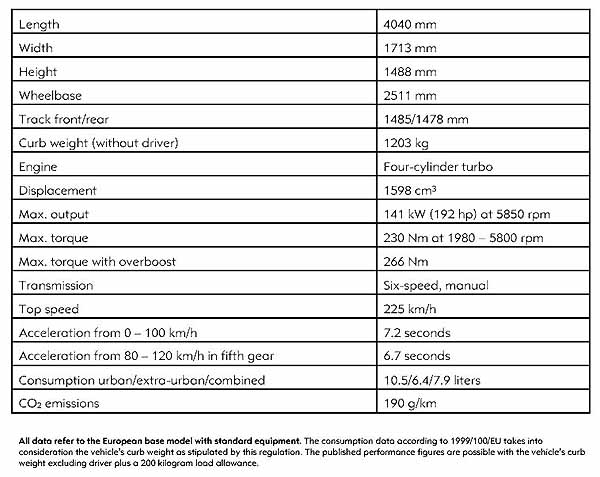
Design: Expressive
Styling with a Passion for Geometry
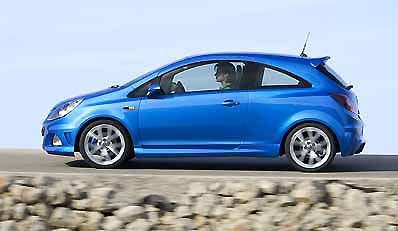 The OPC model range has never been so wide and varied. This
gave the design team the opportunity to design an extraordinary car with
the Corsa OPC. OPC Designer Ulli Hochmuth - responsible for shaping Opel's
sportiest cars since 1999 - says, "The Corsa OPC is aimed at a considerably
younger target group than most of its model family. That's why we styled
the Corsa's sporty lines to be more expressive. We wanted to create an
unmistakable driving machine." Powerful front and rear aprons with distinctive
gills give the compact, bold-looking sporty car a powerful stance, while
the rear spoiler and darkly contrasting diffuser in the rear bumper ensure
good looks and downforce. The front and rear are united by a sporty modeled
side sill and as in other OPC models, the color-keyed crossbar is a distinctive
characteristic of the radiator grille. Attention to detail was just as important
for the designers as the expressive styling, which is apparent from the repeated
use of the triangle. The OPC model range has never been so wide and varied. This
gave the design team the opportunity to design an extraordinary car with
the Corsa OPC. OPC Designer Ulli Hochmuth - responsible for shaping Opel's
sportiest cars since 1999 - says, "The Corsa OPC is aimed at a considerably
younger target group than most of its model family. That's why we styled
the Corsa's sporty lines to be more expressive. We wanted to create an
unmistakable driving machine." Powerful front and rear aprons with distinctive
gills give the compact, bold-looking sporty car a powerful stance, while
the rear spoiler and darkly contrasting diffuser in the rear bumper ensure
good looks and downforce. The front and rear are united by a sporty modeled
side sill and as in other OPC models, the color-keyed crossbar is a distinctive
characteristic of the radiator grille. Attention to detail was just as important
for the designers as the expressive styling, which is apparent from the repeated
use of the triangle.
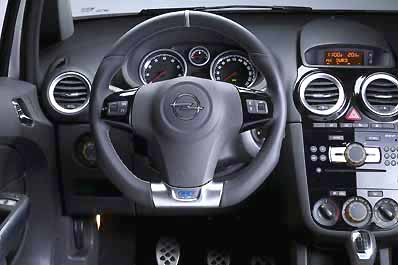 In the Corsa OPC, designers make use of this shape in a variety
of places: from the radiator grille structure and the fog lamp frames to
the perfect, centrally located triangular tailpipe integrated in the rear
bumper. The two clips on the unique, thin exterior mirrors form a triangle
and the spokes on the special, finely crafted 17 or 18-inch alloy wheels
are also triangular. Even the rubber grips on the aluminum pedals are easily
recognizable as Corsa OPC parts. Sportiness also dominates the Corsa OPC's
cockpit. In addition to the typical OPC door sills, chrome-ringed instruments
with red pointers and - depending on upholstery color - blue or silver-ringed
air vents, the flat-bottomed leather sports steering wheel is especially
eye-catching. Also reminiscent of motor sport vehicles, the steering wheel
features a ring at its crown, while the center console in piano lacquer finish
and aluminum pedals underline the sporty, high quality ambience. The sports
seats with integrated head restraints are a joint new development by Opel
and Recaro. These race-car-like seats provide optimal side support and protect
both the driver and front passenger with integrated side airbags. In the Corsa OPC, designers make use of this shape in a variety
of places: from the radiator grille structure and the fog lamp frames to
the perfect, centrally located triangular tailpipe integrated in the rear
bumper. The two clips on the unique, thin exterior mirrors form a triangle
and the spokes on the special, finely crafted 17 or 18-inch alloy wheels
are also triangular. Even the rubber grips on the aluminum pedals are easily
recognizable as Corsa OPC parts. Sportiness also dominates the Corsa OPC's
cockpit. In addition to the typical OPC door sills, chrome-ringed instruments
with red pointers and - depending on upholstery color - blue or silver-ringed
air vents, the flat-bottomed leather sports steering wheel is especially
eye-catching. Also reminiscent of motor sport vehicles, the steering wheel
features a ring at its crown, while the center console in piano lacquer finish
and aluminum pedals underline the sporty, high quality ambience. The sports
seats with integrated head restraints are a joint new development by Opel
and Recaro. These race-car-like seats provide optimal side support and protect
both the driver and front passenger with integrated side airbags. |
Chassis: Thorough
Sporty Tuning On the Nürburgring
Pure driving fun was at the top of the agenda during the Corsa OPC chassis'
design. The sporty, compact car therefore boasts an appropriately sophisticated
balance of agile handling and pronounced vehicle control. The technology
team, consisting of specialists from series production and special vehicle
development, used the Corsa Sport's technical basis to develop an even sportier
setup, assisted by Lotus Engineering experts. The base tuning was set on
the test course in Idiada, Spain, and then development moved to the
Nürburgring Nordschleife. Five test cars with various fine-tunings were
compared by experienced chassis engineers. Racing car driver and brand ambassador
Manuel Reuter was also a regular test crew member. The data obtained from
the circuit was continuously checked for its everyday suitability on the
Eifel Mountains' country roads around the Nürburgring, and there were
also calibration drives at Opel's test center in Pferdsfeld. The final check
was an endurance test of a special kind: over just ten days, the Opel Corsa
OPC had to prove its durability with a 10,000 kilometer hardness test on
the Nürburgring Nordschleife. Key elements of the OPC's chassis, which
has been lowered by 15 mm compared to the base Corsa variants, include a
stronger rear axle profile that increases the roll rate by 25 percent. The
spring/dampener tuning was adjusted accordingly and an optimum characteristic
chosen for the gas-pressure shock absorbers. The standard ESP system, which
can be deactivated, was also tuned to the car's sporty character. The new
Corsa OPC comes with 7 J x 17 alloy wheels with 215/45 R17 tires ex works,
while 7.5 J x 18 rims and size 235/35 R 18 tires are available as an option.
The large 16-inch brake system with blue painted brake calipers ensures strong
deceleration: the Corsa OPC boasts internally ventilated, 308 mm front disk
brakes and 264 mm disk brakes at the rear.
Variable-progressive
steering for sports car feeling
A unique feature for this class is the Corsa OPC's variable-progressive steering,
which provides a true sports car feeling. With a ratio of 13.0:1 during
straight-ahead driving, the system response is already very direct. As the
turning angle increases, so does the level of direct response, so that by
90 degrees the ratio is at 11.8:1. The variable progression also ensures
that the response ratio increases again at greater steering-wheel angles
to up to 13.3:1, reducing the effort needed for maneuvering or parking.
Engine: High
Performance Density, Even More Torque with Overboost
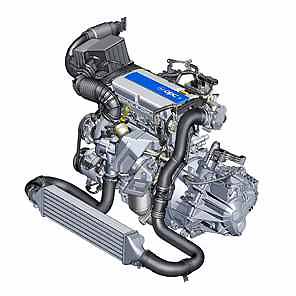 The Corsa OPC's turbo engine produces 141 kW/192 hp at 5850
rpm. Compared to the Meriva OPC and current turbo variants in the Astra
generation, the induction air and exhaust gas routing has been further optimized.
This not only improves the engine's maximum power output, but also its propulsion
power. The maximum torque of 230 Nm, available across a wide range between
1980 and 5850 rpm, is delivered to the front wheels by the standard six-speed
transmission. In addition, the standard 'overboost' system can temporarily
increase torque by around 15 percent to 266 Nm when required, providing a
corresponding dynamics increase. These elements all combine to give the most
compact OPC model driving performance like a sports car. The turbo engine
accelerates the Corsa from zero to 100 km/h in 7.2 seconds and enables a
top speed of 225 km/h, while quick intermediate sprints highlight the high
level of torque: accelerating from 80 to 120 km/h takes the three-door car
just 6.7 seconds in fifth gear. The Corsa OPC requires 7.9 liters of fuel
per 100 kilometers, a moderate figure in this performance class. The clever,
light construction is a distinguishing characteristic of the standard engine.
Including the aluminum bearing cover, the grey cast iron block weighs only
27 kg. Using this material also saves on extensive, heavy noise reduction
measures around the engine. The cylinder head, sump and turbo-specific induction
manifold with side-mounted throttle valve in the Corsa OPC are all made from
aluminum. The turbocharger housing is integrated into the cast exhaust manifold
- an Opel-typical design and optimal for the turbocharger's weight and fast
reaction. The water-cooled turbocharger was developed jointly by Opel and
specialists BorgWarner Turbo Systems (previously KKK). It boasts refined
stream geometry, improved materials and a longer service life. At 131 kg,
the high-performance engine is extremely light and only 15 kg heavier than
the aspirated variant. New turbo engines from competitors in this displacement
class are up to 15 kg heavier. The four-valve engine's valve timing has also
been optimized. Compared to the aspirated engine, the camshaft spread was
decreased from 232° to 223° and the valve stroke reduced from 8.5/9.5
mm to 7 mm, as the maximum overpressure of 1.3 bar from the turbocharger
automatically ensures good charge. With a cutoff rpm of 6500, the direct
valve travel via flat-base tappets is weight and friction optimized. With
a bore/stoke ratio of 79/81.5 mm and 1598 cm3 displacement, the compact OPC
engine provides top performance in terms of specific output (88 kW/120 hp
per liter of displacement) and specific torque (144 Nm/liter). The unit is
also well suited for the future. The upstream catalytic converter and the
new engine control unit used in hybrid technology already meet the requirements
for the upcoming Euro 5 emissions standard. The requirements for natural
gas (CNG) and biofuel (alcohol) operation were also taken into consideration
during design. The Corsa OPC's turbo engine produces 141 kW/192 hp at 5850
rpm. Compared to the Meriva OPC and current turbo variants in the Astra
generation, the induction air and exhaust gas routing has been further optimized.
This not only improves the engine's maximum power output, but also its propulsion
power. The maximum torque of 230 Nm, available across a wide range between
1980 and 5850 rpm, is delivered to the front wheels by the standard six-speed
transmission. In addition, the standard 'overboost' system can temporarily
increase torque by around 15 percent to 266 Nm when required, providing a
corresponding dynamics increase. These elements all combine to give the most
compact OPC model driving performance like a sports car. The turbo engine
accelerates the Corsa from zero to 100 km/h in 7.2 seconds and enables a
top speed of 225 km/h, while quick intermediate sprints highlight the high
level of torque: accelerating from 80 to 120 km/h takes the three-door car
just 6.7 seconds in fifth gear. The Corsa OPC requires 7.9 liters of fuel
per 100 kilometers, a moderate figure in this performance class. The clever,
light construction is a distinguishing characteristic of the standard engine.
Including the aluminum bearing cover, the grey cast iron block weighs only
27 kg. Using this material also saves on extensive, heavy noise reduction
measures around the engine. The cylinder head, sump and turbo-specific induction
manifold with side-mounted throttle valve in the Corsa OPC are all made from
aluminum. The turbocharger housing is integrated into the cast exhaust manifold
- an Opel-typical design and optimal for the turbocharger's weight and fast
reaction. The water-cooled turbocharger was developed jointly by Opel and
specialists BorgWarner Turbo Systems (previously KKK). It boasts refined
stream geometry, improved materials and a longer service life. At 131 kg,
the high-performance engine is extremely light and only 15 kg heavier than
the aspirated variant. New turbo engines from competitors in this displacement
class are up to 15 kg heavier. The four-valve engine's valve timing has also
been optimized. Compared to the aspirated engine, the camshaft spread was
decreased from 232° to 223° and the valve stroke reduced from 8.5/9.5
mm to 7 mm, as the maximum overpressure of 1.3 bar from the turbocharger
automatically ensures good charge. With a cutoff rpm of 6500, the direct
valve travel via flat-base tappets is weight and friction optimized. With
a bore/stoke ratio of 79/81.5 mm and 1598 cm3 displacement, the compact OPC
engine provides top performance in terms of specific output (88 kW/120 hp
per liter of displacement) and specific torque (144 Nm/liter). The unit is
also well suited for the future. The upstream catalytic converter and the
new engine control unit used in hybrid technology already meet the requirements
for the upcoming Euro 5 emissions standard. The requirements for natural
gas (CNG) and biofuel (alcohol) operation were also taken into consideration
during design. |
Seats: Sporty
Body-Contoured Design, New Geometry
With plenty of side support - the most important element of any sport seat
- ideal suitability for long journeys and high levels of seating comfort
for passengers of all statures, the Opel Corsa OPC's front seats are truly
multi-talented. Developed jointly by Opel and Recaro, they not only look
like race-car seats, but are also based on a plastic shell. The advantage
of this design is that contouring and pressure distribution can be better
controlled than in conventional, mass-produced, steel-framed passenger-car
seats. Corsa seats are produced by a thermoplastic injection molding process,
with glass fibers to reinforce the plastic. The integration of head restraints
and side airbags ensures a high level of safety. Corresponding cutouts in
the seat backs allow four-point safety belts to be retrofitted. There is
no reduction in the level of practical suitability, as the new OPC seats
feature the familiar Easy-Entry function for trouble-free access to the rear.
Height adjustment is fitted as standard, as are heated seats for the optional
full nappa leather interior. The new seating geometry combines good side
support with a comfortable sitting position. "We designed the seat surface
so that it's narrower at the rear for a good body posture and wider at the
front so the legs have plenty of room," says Armin Roßmann, Design
Engineer. The shape was designed with the help of the computer-based human
model RAMSIS. Ergonomics and long-journey suitability were assessed by seat
specialists in a range of different practical tests. These included using
sensors in the prototype cars on long trips to objectively determine whether
the driver sits comfortably in one position or not. If the driver then keeps
the position over long distances, the ergonomics are ideal. The new OPC seat
passed this test with flying colors, as well as another obligatory check:
employees of different statures tried out the seat on special stretches of
Opel's test center in Dudenhofen. They then gave marks for criteria such
as entry, seating position, cornering and lumbar support. The side airbags
in the Corsa OPC's sport seats are also an innovation. A joint development
by Opel and Recaro, they are integrated into the seat backs - a first for
a series production, folding body-contoured seat.
READER COMMENTS
Adam Opel AG, A member company
of the GM Group,
Ein Unternehmen der GM Gruppe,
 General Motors Corporation
General Motors Corporation
January 2007 |
BACK TO TOP |